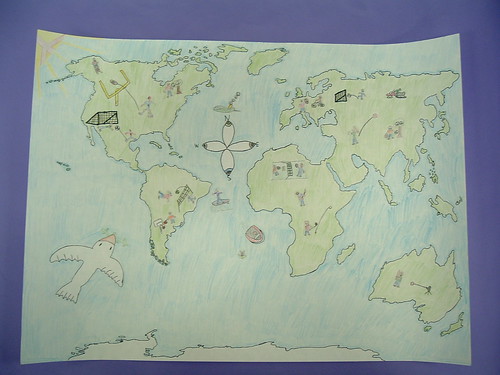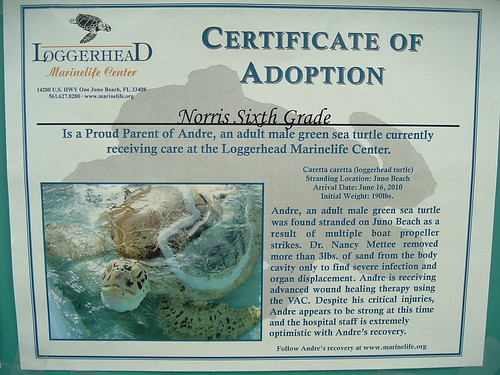 It’s that time of year again — the time when I leave my classroom for a few days to join all of my wonderful National Writing Project colleagues for our Annual Meeting. In about 10 days, we head to Orlando, Florida (same place as NCTE) and convene together to learn, discuss and debate the many intersections of writing, technology and learning. (And I am doubly lucky because my wife is joining me again this year. She is part of a NWP venture to develop curriculum for the writing-centered Common Core Standards that is being funded by the Gates Foundation).
It’s that time of year again — the time when I leave my classroom for a few days to join all of my wonderful National Writing Project colleagues for our Annual Meeting. In about 10 days, we head to Orlando, Florida (same place as NCTE) and convene together to learn, discuss and debate the many intersections of writing, technology and learning. (And I am doubly lucky because my wife is joining me again this year. She is part of a NWP venture to develop curriculum for the writing-centered Common Core Standards that is being funded by the Gates Foundation).
I am presenting with two NWP sessions in Orlando.
The first session is about how technology can help some of our rural NWP sites connect with their teachers when geographic barriers exist, and also how those teachers and their students can connect with others in the world through technology. I’ll be talking about some of the various projects, such as Voices on the Gulf, Longfellow 10, the iAnthology, and more. Although access to computers will probably be an issue for many rural teachers, there are plenty of ways that classrooms and teachers can open up the learning experience to the world.
Here’s the blurb for Providing Writing Project Access Across Geographic Boundaries:
Participants will examine solutions that provide Writing Project access and programs to rural teachers when participation is hampered by geographic barriers. Participants will analyze current practices of outreach to rural teachers, explore promising site practices and technological tools for providing access, and create a plan for making their sites more accessible to rural teachers.
I am also a presenter at the NWP Makes! session that teams up the writing project with Make Magazine for a fun, interactive session around technical writing. I’ll be walking my group through a stopmotion animation project, and then they’ll be documenting what we did. (see my sample) I think the artifacts from this session will eventually be part of a collection at the new NWP Digital Is site.
Here’s the blurb:
A special Saturday event hosted by the NWP Digital Is project’s partnership with Make magazine. Participants will be invited to explore the connections between making and technical writing through hands-on projects and shared reflection. Come to learn about the making/crafting/tinkering/DIY movement and explore connections to your own practice.
I am also attending a handful of interesting sessions as a participant.
I am going to be part of a Digital Literacies Roundtable.
In this roundtable session, multiple presenters will share a range of innovative digital practices—from multimodal composing in the classroom, to working with families to explore the digital literacy practices of youth, to being a writer and learner in virtual worlds and communities. Together, presenters and participants will use these examples to think and talk about the role of digital literacies in our lives and the lives of our students. We will participate in a shared inquiry about what digital literacies afford in terms of identity, participation, and community, and explore what it means to be digitally literate citizens today.
And I am going to be in a two sessions around gaming in the classroom.
The first session: Games for Education and Social Impact
Alan Gershenfeld is founder and president of E-Line Media, which has helped build some of the world’s leading game and digital comic franchises and which supports social entrepreneurs committed to harnessing popular media for impact. In this session Gershenfeld will demonstrate video games that can be used to tap into kids’ natural passion for play while harnessing that passion toward games that have positive social impact.
The second session: Building Video Games for and in the Classroom
This session, which builds on the lunchtime presentation “Games for Education and Social Impact,” will introduce specific platforms that help students and teachers alike make games to support learning in the classroom. In particular, Alan Gershenfeld from E-Line Media  will introduce Gamestar Mechanic, a browser-based game specifically built on leading pedagogical research in the areas of systems thinking, 21st century digital literacy skills, and STEM learning.
will introduce Gamestar Mechanic, a browser-based game specifically built on leading pedagogical research in the areas of systems thinking, 21st century digital literacy skills, and STEM learning.
And, I am going to be learning more about the upcoming NWP Social Networking Project called Going On, which is in a beta stage right now. The idea is to create a sharing space for NWP teachers.
The blurb:
NWP has developed a new social networking and social media space, GoingOn, connected to our NWP.org website. Find out how your local Writing Project site can develop its community within this space, which features blogs, wikis, and the ability to share images, audio, and video.
Plus, the keynote speaker is Donalyn Miller. I attended a workshop of hers last year as she talked about her idea around reading and literacy (she is the Book Whisperer, and author of the book with that title), and we connect on Twitter now and then. She will no doubt be fantastic, and inspirational as hundreds of NWP teachers come together for the General Session.
And I am hoping to reconnect with some NWP Twitter friends in a tweet-up that my friend Paul Oh is organizing for Friday night. So, plenty to keep me involved and engaged, and then also, of course, I’m carving out time to be with my wife. (We’re staying an extra day!)
Phew. That’s a lot going on in just a few days. I’ll be blogging about my days here, of course, and also, when I have access, putting stuff up on my twitter account (we’re going to be using the #nwpam10 hashtag for those who want to follow along).
Peace (in the magic kingdom of writing),
Kevin





